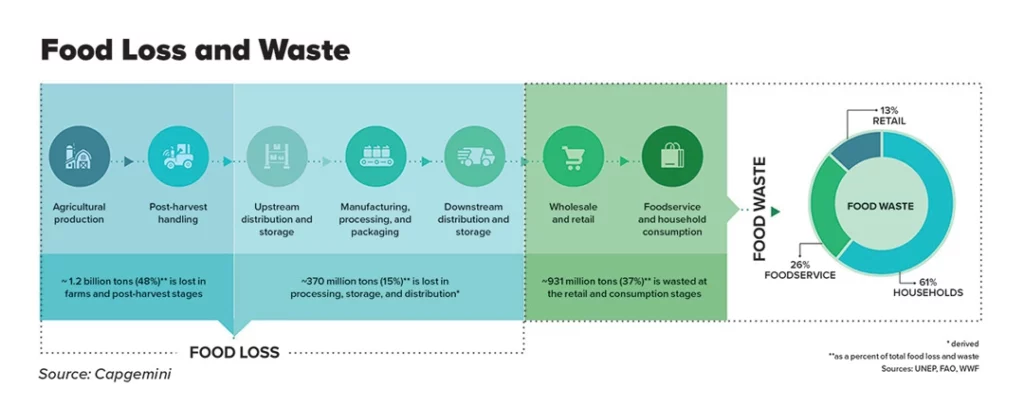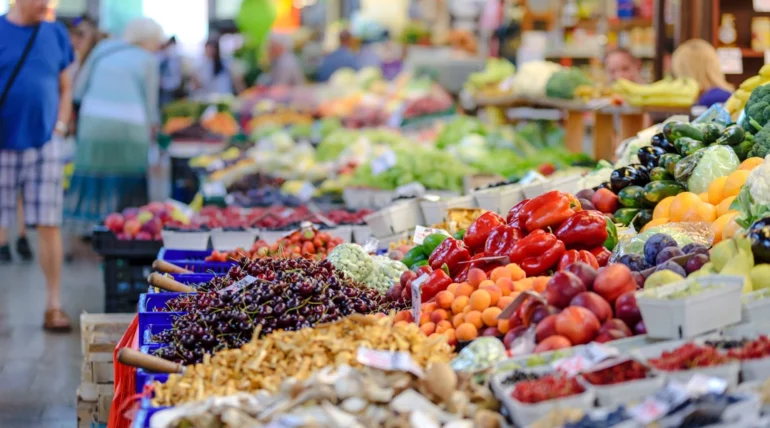Food waste is a pressing issue affecting not only our wallets but also the environment.
In the United States alone, we discard approximately 60 million tons of food annually, which results in a staggering $218 billion in financial losses.
This means that the US squanders the equivalent of 130 billion meals – food that, if stored and distributed properly, could provide sustenance to countless hungry individuals worldwide.
The good news?
Much of this food waste can be reduced at the grocery store level. Let’s explore why grocery stores end up wasting tons of food annually and how they can reduce it.
Why Do Grocery Stores Waste Food?
Do you know how much food is wasted in grocery stores exactly?
Supermarkets and retailers end up discarding about 30% of their food.
Here are some of the main reasons why they are some of the biggest contributors to this global issue:
Storage
One of the primary reasons for food waste at grocery stores is bad storage conditions. Here are a few bad storage practices that lead to faster food spoilage:
- Lack of stock rotation: When unpacking and displaying products, it’s essential to follow proper stock rotation procedures. This ensures older products are pulled to the front, highly perishable produce is dealt with first, and backroom stock is rotated often. Otherwise, even the most durable products can get damaged and never bought (especially if you have a picky clientele).
- Improper space allocation: While stacking all the produce can be easier for staff so they don’t have to restock throughout the day, this ends up creating more food waste. Instead, aim to predict customer demand and stock optimal quantities that can still be beautifully set up but without over-allocating products.
- Too much evaporation: Produce isles are chill and circulate air constantly. This can literally shrink and dry out some perishables. To battle this problem, you can use manual or automatic sprayers to keep the produce fresh.
- Cross-contamination: Mixing raw and cooked food while in storage is a big no-no. Even if the products have their own separate packaging, the chances of cross-contamination are still pretty high. To minimize the risk, keep raw and cooked foods separate.
- Pallet stacking: Double stacking of pallets prevents proper air circulation and can result in longer cooling down or freezing processes. This, in turn, can speed up the growth of bacteria and reduce the shelf life of your products.
- Cold chain mismanagement: Maintaining the same temperature can be hard. If the delivery truck had a slightly lower/higher temperature than your storage space, the cold chain could be easily broken down, leading to faster spoilage.
Expiry Dates
There’s a lot of confusion surrounding what the expiry dates mean when it comes to food safety. This results in wrong assumptions and many cases of perfectly safe foods being thrown away.
Sell by vs. Use by vs. Best Before Dates
Here’s what these terms really mean:
- Sell by: This date indicates until when consumers can purchase the product before grocery stores remove it from sale.
- Use by: This indicates the date before which the food should be consumed. Such dates can be found on perishables like fish and meat.
- Best before: These are labels used on fruits and vegetables and identify the optimal time to consume them. While fruits and vegetables past the “best before” date might not be as fresh, they are still perfectly safe to consume.
Changing these confusing expiry date formats so consumers understand them is a powerful way to reduce food waste.
Inefficient Inventory and Stock Management
Depending on the size of your business, you might have to manage a large storehouse or small self-storage space.
Whatever the case is, here are a few often-occurring inventory and stock management issues:
- Inconsistent and infrequent inventory counts: Inefficient inventory management often leads to discrepancies between recorded stock and actual quantities. Without timely reconciliation, you might not be able to identify expired or near-expiry items, increasing the likelihood of food spoilage and waste.
- Lack of real-time product information tracking: Not being able to track product information in real-time can lead to lots of issues, including overstocking, understocking, and failing to identify and address inventory issues promptly. What’s more? Not monitoring product prices over time can result in outdated or overpriced inventory.
- Absence of streamlined receiving and returns processes: Failing to verify incoming deliveries against purchase orders can lead to product spoilage and receiving incorrect or damaged goods. Similarly, lacking a systematic returns procedure may result in unsold inventory being left unaccounted for, further increasing waste.
- Inadequate sales tracking and analysis: Failing to track and analyze sales data can lead to a bunch of problems, like failing to understand demand fluctuations, which in turn, can result in excess stock levels. But if you manage to monitor sales trends, identify slow-moving products, and adjust inventory accordingly, you can minimize the waste caused by unsold items.

How Can Grocery Stores Reduce Food Waste
Reducing food waste is a daunting challenge that retailers need to solve.
Here are three grocery store food waste solutions:
Donating to Food Banks and Associations
There are at least 371 food banks across America.
Donating surplus food to such establishments is a great way for grocery stores to combat food waste.
However, only food that isn’t expired can qualify for donations. So, to make this work, grocery shops need to have accurate forecasting on supply-demand discrepancies way before the expiration date is due.
But there’s still much to be done to create a streamlined flow of surplus food from grocery stores to food banks. For example, in 2021, the US generated 91 million tons of “surplus food”, and while 80% of this food was edible, only 2% was donated.
However, there is still some progress with some stores, like Kroger, that are regularly donating to food banks and local communities. Kroger has pledged to donate three billion meals by 2025, showcasing the potential impact of such initiatives.
Furthermore, the European Food Banks Federation is encouraging businesses to join the “Food No Waste” challenge. Collaborations with local restaurants, innovative food waste apps, and cookbooks are among the ideas implemented to ensure surplus food finds its way to those who need it most.
Adopting Food Technology
Harnessing the power of technology can significantly aid grocery stores in managing food waste.
Food technology can help with:
- Reducing food waste due to expiry date limits: Expiration date tracking technology can now monitor and flag products nearing expiration. This enables stores to proactively discount and sell these items before they go to waste. Examples like the Wasteless dynamic pricing system and the Too Good To Go app help connect consumers with surplus food at discounted prices.
- Identifying waste patterns: Supermarkets possess a wealth of information that can help them predict demand and order the right amount of food when analyzed efficiently. For example, Walmart’s Intelligent Retail Lab allows the store to optimize stock levels and respond to consumer preferences accurately. By leveraging shopping data and artificial intelligence, supermarkets can anticipate demand, reduce waste, and ensure that products are available at the right time and in the right store.
- Improving inventory planning: Inventory management apps can give you real-time data on the products you have in store, along with any key information you need to make better decisions. Such software can even help you plan future orders and analyze inventory movement patterns across different store locations.
Other food waste technologies involve recycling grocery store food waste (helping with food that’s already spoiled). These include processes like turning food waste into compost or biogas through anaerobic decomposition.
Train Staff on Grocery Store Food Waste
Damage to food and packaging often occurs during transit and storage. But proper training and raising awareness among staff members can make all the difference.
For example, eliminating simple mishaps (like placing heavy items on delicate produce and disruptions in the cold chain) can significantly mitigate these issues. That’s especially true for large grocery shops and supermarkets where technology is often complicated and minor mistakes can result in big losses.
By providing comprehensive training to staff members, supermarkets can significantly reduce food waste. For example, Metro Cash in Germany trains its staff on all aspects of hygiene, food safety, and sustainable resource handling.
By fostering a culture of waste reduction and equipping employees with the necessary knowledge and skills, supermarkets can minimize food loss and increase marketable products, while also promoting sustainable practices.
How Collaboration Can Help Solve the Problem of Grocery Store Food Waste
Food waste can be eliminated at multiple levels in the supply chain. But to do this, grocery stores need to collaborate with legislators, NGOs, farmers, food processors, and entrepreneurs.
Here are a few ways supermarkets can collaborate with different stakeholders to reduce food waste:
Collaborate with Legislators
Currently, in the New York state area, the Excess Food Act requires supermarkets (larger than 10,000 square feet) to donate all their excess food to food banks and other charities.
Some other states also have passed relevant food waste grocery stores laws to restrict food waste that occurs at the retail level.
Modify Inefficient Store Practices
A few traditional supermarket practices that lead to food waste are:
- High cosmetic standards: We get it – customers can get picky. That pressures supermarkets to enforce very stringent cosmetic standards for fruits and vegetables (like improper shape, slightly different color, etc.) This leads to the rejection of perfectly edible but visually imperfect produce. To combat this, grocery chains can sell this produce at discounted prices, reducing waste and providing affordable options for customers.
- Misleading expiration product labeling: Currently, the expiration date formats are not regulated. Usually, manufacturers create these labels themselves, resulting in products with different expiration date formats. This leads to a lot of confusion, and consumers end up throwing away perfectly fine products. Retailers can advocate for standardized labeling, replacing ambiguous “best by” dates with clearer indications like “best if used by” or “sell by.”
- Well-stocked displays: Grocery stores often aim to stock up all their displays for consumers. But, in fact, piling leads to more damaged produce. By implementing strategic product displays, supermarkets can extend shelf life, leading to substantial cost savings and fresher produce.
Team Up with Farmers
Did you know that about 7% of food waste occurs in the fields (in the form of unharvested produce)?
Retailers can significantly reduce agricultural food waste by partnering with farmers and sharing forecast data with them. This can help:
- Optimize production
- Prevent overplanting
- Improve efficiency
- Increase product quality
Also, collaborating with agri-tech ventures allows big retailers to help smallholder farmers in cutting waste, increasing productivity, and gaining better market access.
Partner with Consumers
As a food retailer, you can take on a proactive approach to educating consumers about reducing household food waste.
You can share inspiration, guidance, and practical tips to empower customers to make a positive change.
For example, you can:
- Start a free food magazine featuring waste reduction tips and recipes for utilizing leftovers.
- Collaborate with chefs who can demonstrate how to use leftover ingredients.
- Organize events showcasing meals made from discarded food.
- Launch “waste less” campaigns, encouraging consumer participation through crowdsourcing ideas for waste and hunger prevention.
How Can Shapiro Help?
A smooth and effective food supply chain is a challenging endeavor that requires adequate expertise, budget, and communication.
Feeling lost on where to start on your food waste reduction journey?
The best thing you can do in this case is to entrust an experienced food waste management partner like Shapiro.
With our extensive experience in the field, we offer commercial food waste recycling and management solutions for managing and minimizing damage at various levels of the food supply chain.
Ready to optimize operations, reduce waste, and commit to sustainability? Together, we can create a more efficient and sustainable food system.
Contact us today to learn more about how we can help you reduce food waste.
Baily Ramsey, an accomplished marketing specialist, brings a unique blend of anthropological insight and marketing finesse to the digital landscape. Specializing in educational content creation, she creates content for various industries, with a particular interest in environmental initiatives.



